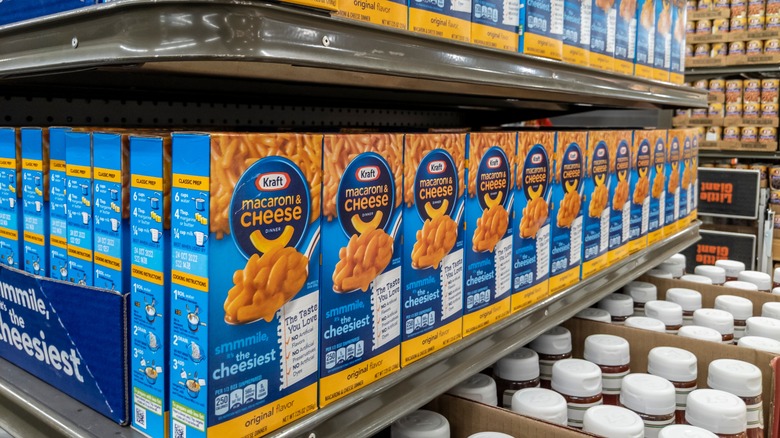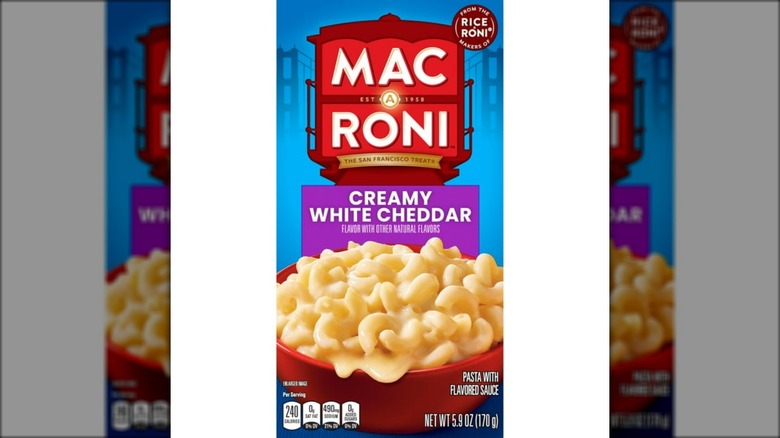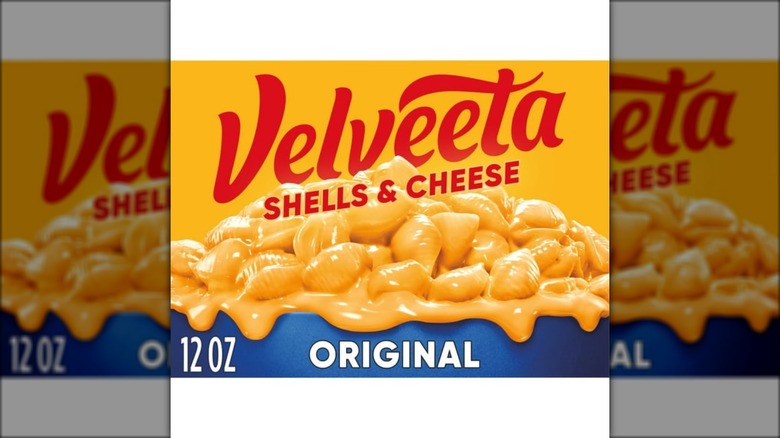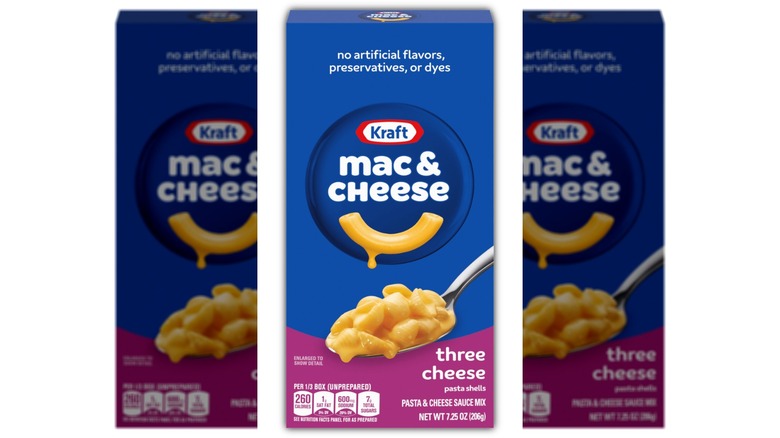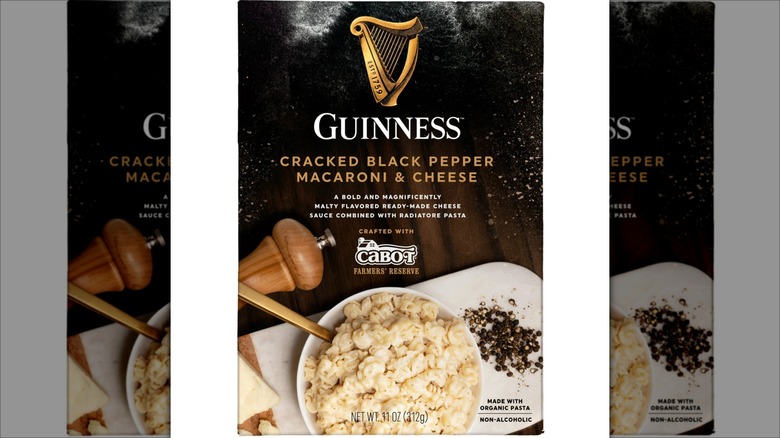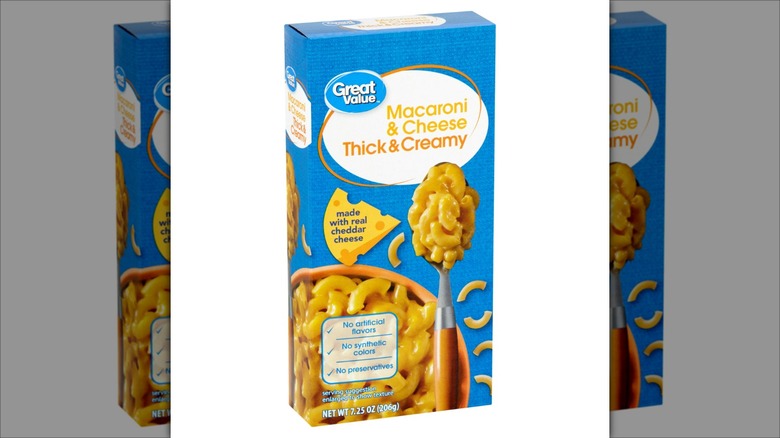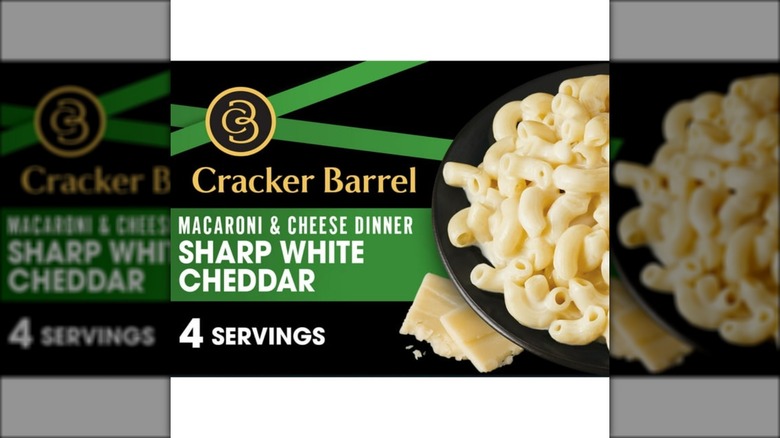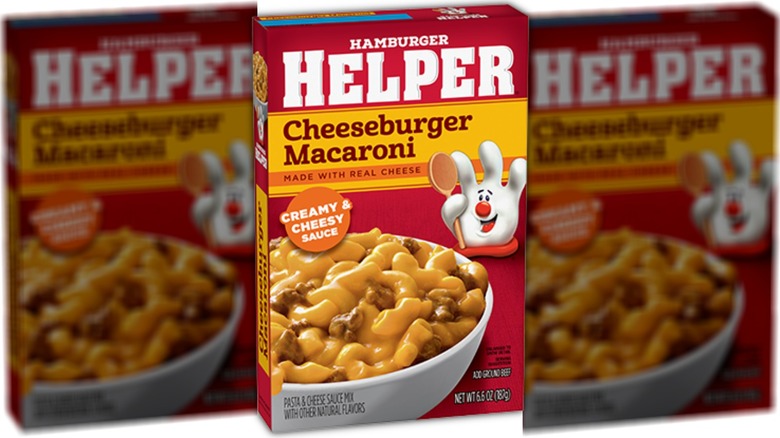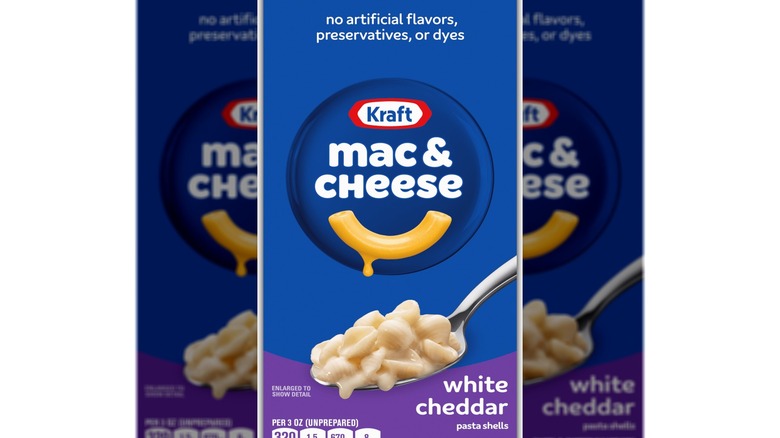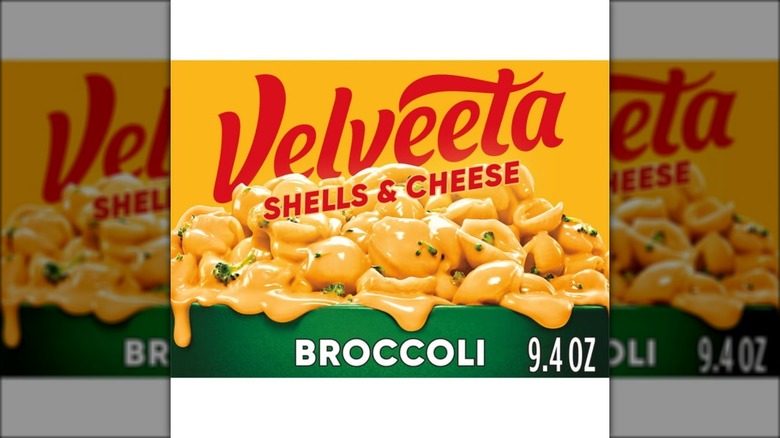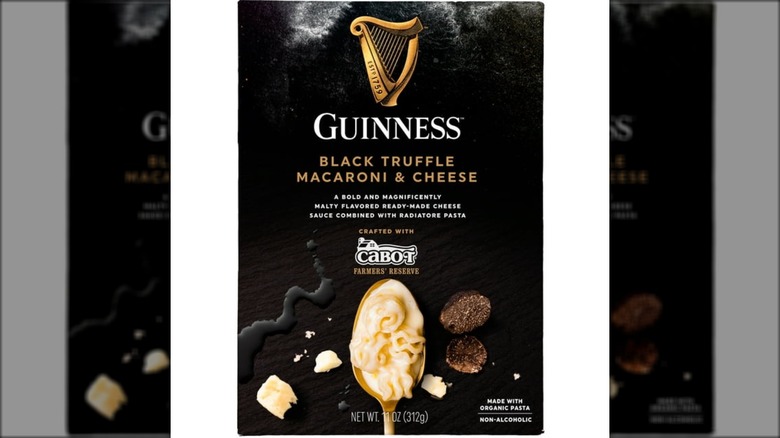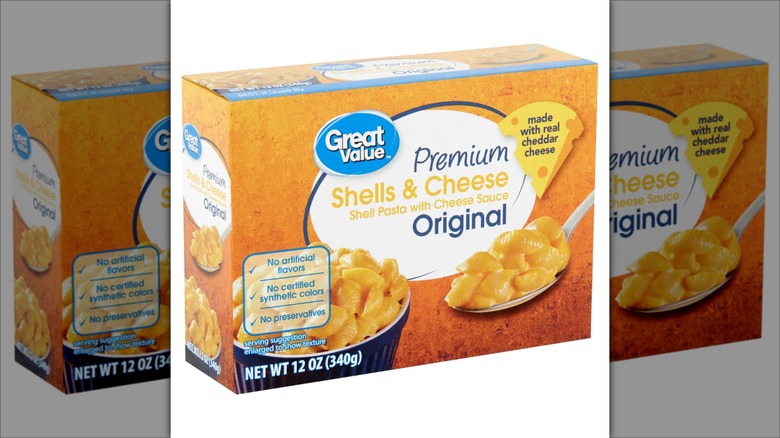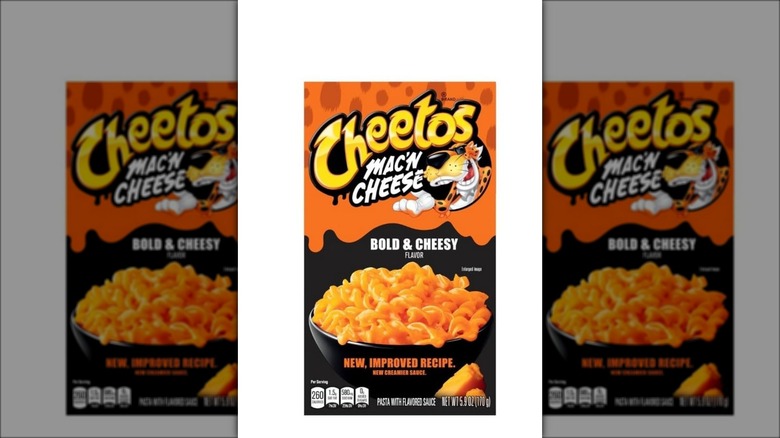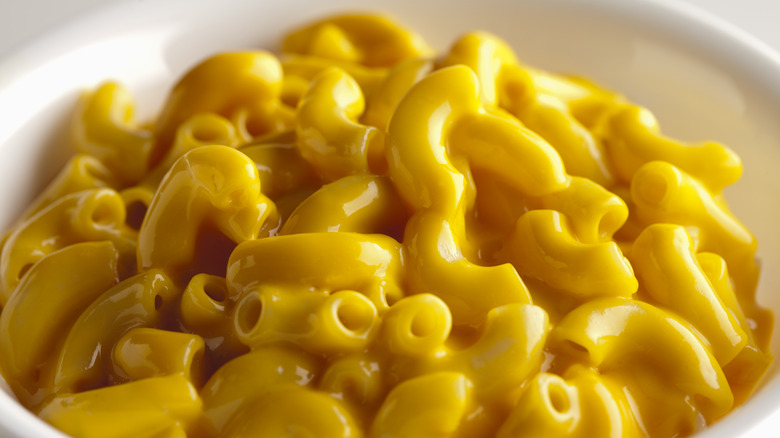12 Unhealthiest Boxed Macaroni And Cheeses You Can Buy
We may receive a commission on purchases made from links.
From last-minute dinners to midnight snacks, boxed macaroni and cheese is a lifelong comfort food. No matter what changes in life, you can always count on that finished pot of creamy, hearty pasta hitting the spot — even if you know it's not that good for you.
As you'd probably expect from something that contains powdered cheese, boxed macaroni and cheese isn't the most nutritionally sound meal, especially if the instructions require you to combine the contents of each box with a hefty amount of milk or butter. There have also been concerns in the past that this highly processed powdered cheese contains alarming levels of phthalates (AKA the hormone-disrupting chemicals used to make plastic more durable).
None of this is to say that you should totally cut boxed macaroni and cheese from your diet. What is life without the odd congealed, cheesy indulgence? However, if you're keeping a close eye on your sodium and saturated fat intake, or just want to avoid additives that sound more appropriate in a science lab than your kitchen, some choices are unhealthier than others. These are 12 of the worst offenders stocked in grocery stores.
Quaker Mac-A-Roni with Creamy White Cheddar Flavor
Considering the fact that each serving of Quaker Mac-A-Roni with Creamy White Cheddar Flavor requires 4 tablespoons of butter and a quarter cup of 2% milk, you can probably guess that saturated fat is the biggest issue. Once prepared, a single serving of this macaroni and cheese contains an eye-popping 12 grams of saturated fat — about 60% of the amount you're supposed to eat in an entire day. And that's if you just stick to the one serving. (Realistically, how often do you actually stretch one box into 2.5 servings?)
Fat aside, you'll also find 420 calories, 50 grams of carbohydrates, and 690 milligrams of sodium. In comparison, it also contains just 2 grams of fiber, which means you're unlikely to feel satisfied for long after you eat. More fiber would also help to slow down the rate at which your body digests the 50 grams of carbs in each serving, in turn stabilizing your blood sugar and preventing that familiar post-carb crash.
Velveeta Shells & Cheese
Let's start with the silver lining here. Velveeta Shells & Cheese somehow manages to be both creamy and cheesy without requiring any actual butter or milk. Instead, it just calls for water to boil the shells, with the iconic Velveeta cheese sauce then applied directly to the pasta after draining. No extra dairy additions means the amount of saturated fat in each serving (3 grams) is actually relatively low compared to other entries on this list.
That silver lining is short, because we're not quite as keen on the rest of Velveeta Shells & Cheese's nutritional profile. A single serving of this macaroni and cheese contains a whopping 860 milligrams of sodium. That's 38% of your daily recommended intake gone in just one-third of a box. Yet again, there's also next to no fiber (there's 1 gram, if that counts for anything), so you run the risk of feeling hungry again not long after you threw away 38% of that sodium allowance. If you want to hack this macaroni and cheese into something a little more nutritionally impressive, try pairing it with a side of carrots, broccoli, cauliflower, or another veggie rich in fiber, which will help you feel full for longer.
Kraft Three Cheese Mac & Cheese
You don't have to love Kraft Mac & Cheese, but you can't deny its prestige. Back in 1937, this was the OG boxed macaroni and cheese, picking up steam among American consumers thanks to its low price (19 cents, to be precise) and maximum efficiency (according to the Smithsonian, a single box promised to "make a meal for four in nine minutes").
Sadly, it costs a little bit more than 19 cents over eight decades later, but it's still a pretty affordable and convenient meal option. Back in 2015, Kraft quietly gave its macaroni and cheese range an overhaul which rid it of all artificial flavors, preservatives, and dyes. That means the usual offenders of yellow 5 and yellow 6 no longer play a part in the deliciousness of any of its blue boxed pasta.
But that doesn't mean that all of its products are flawless, with the Kraft Three Cheese Mac & Cheese still finding a spot on our list of the unhealthiest macaroni and cheese. Once prepared with the suggested amount of butter and milk, each serving contains 750 milligrams of sodium (a third of your daily recommended intake, and well over the maximum of 600 milligrams recommended per meal to limit its impact on your blood pressure) and 4 grams of saturated fat. The fiber count is also disappointingly low at just 1 gram.
Guinness Original Macaroni & Cheese
In 2023, Cabot combined two classic flavors to create something that's in equal parts a monster and a masterpiece (depending who you ask): Guinness Cracked Black Pepper Macaroni & Cheese. While it doesn't contain any actual alcohol, this macaroni and cheese has a malty taste just like the popular stout that compliments Cabot's famously sharp cheddar.
Love it or hate it, this unique macaroni and cheese is definitely best enjoyed as an occasional indulgence; each serving contains 4.5 grams of saturated fat and 1,200 milligrams of sodium — 52% of your daily recommended intake. This is a truly mind-blowing amount of sodium. For context, although the FDA suggests that we should consume a maximum of 2,300 milligrams per day, the American Heart Association wants us to move towards a cap of 1,500 milligrams to tackle high blood pressure and heart health. Needless to say, the Guinness Cracked Black Pepper Macaroni & Cheese is best avoided for those already fall into the danger zones for either of these conditions — and probably even those who don't.
Great Value Original Macaroni & Cheese
As far as value goes, this macaroni and cheese truly is great. A three-serving box costs just $0.58 from Walmart at the time of writing. What isn't quite as "great" is its nutritional profile, which leaves a lot to be desired. Once prepared with the recommended four tablespoons of butter and half cup of 2% milk, a single serving contains 410 calories and 4 grams of saturated fat.
Again, the most concerning thing here is the sheer amount of salt you're consuming every time you eat Great Value Original Macaroni & Cheese. At 690 milligrams, you'll be eating up 30% of your sodium allowance in a matter of minutes. While sugar content typically isn't your biggest concern when you're eating macaroni and cheese, it's worth noting that each serving also contains 10 grams of the sweet stuff, too. To give it some credit, there are no artificial flavors, synthetic colors, or preservatives at play here, but that's pretty tough to appreciate given the circumstances.
Cracker Barrel Sharp White Cheddar Mac N Cheese
First thing's first: no, this has absolutely zero connection to the food served in Cracker Barrel restaurants. The cheese brand known as Cracker Barrel was founded by Kraft in 1954, 15 years before anyone stepped foot into the restaurant of the same name. One thing the pair do have in common is their proclivity for fat and salt, with the Cracker Barrel Sharp White Cheddar Mac N Cheese coming up high in both aspects.
It's the sodium that stands out most, with an astonishing 820 milligrams in each serving. Marginally better (and we mean very, very marginally) is the regular sharp cheddar variety, which contains 780 milligrams. However, the downside is the increase in saturated fat; this option contains 4.5 grams of saturated fat, which is 1 gram more than the white cheddar. Whatever variety you go for, you can rest easy (or uneasy?) in knowing that they're both equally disappointing on the fiber front, with just the 1 gram to help your body process all those carbs.
Hamburger Helper Pasta Cheeseburger Macaroni
Cheeseburgers tend to be unhealthy and so does macaroni and cheese, so is it any surprise that their lovechild is (drumroll please) unhealthy? Unlike most macaroni and cheese, which usually requires just water or, at the most, milk and butter to complete the recipe, Hamburger Helper Pasta Cheeseburger Macaroni asks for you to mix in an entire pound of lean ground beef during the preparation process.
The finished result is a glorious mix of cheese and beef that, sadly, your body probably won't enjoy as much as your tastebuds. One serving contains 40% of your daily recommended amount of sodium, plus 19% of your daily cholesterol values. The fiber situation is particularly dire, with less than 1 gram in said serving. What's more, the ingredients list also raises a few alarm bells thanks to the inclusion of four different artificial colors. This lineup includes the infamous yellow 5 (AKA tartrazine) and yellow 6. Studies suggest that both are damaging to our cells and potentially contaminated with carcinogenic substances. Tartrazine, in particular, has also been linked to hyperactivity and behavioral changes in children. All in all, it's definitely not an ingredient that would appear on any nutritionist's wish list.
Kraft White Cheddar Mac & Cheese
The second Kraft Mac & Cheese appearance on this list comes courtesy of the White Cheddar variety. Billed as boasting a sharper, stronger flavor than the regular cheddar, the price for treating your tastebuds is a shocking amount of salt. Once you're done preparing your serving of Kraft White Cheddar Mac & Cheese, you're left with a bowl containing 840 milligrams of sodium (37% of the maximum amount you're suggested to eat each day for the sake of your blood pressure and heart health).
You'll be pairing this salt with 5 grams of saturated fat and 60 grams of carbohydrates, including 9 grams of sugar. Unsurprisingly, these stats are backed up by very little fiber (2 grams per serving). The result is a mass of comfortingly cheesy goodness that has the potential to spike your blood sugar and put you in a post-dinner food coma, as is often the case with highly-processed, starchy carbs.
Velveeta Broccoli Rotini & Cheese
Don't make the mistake of reading "broccoli" and defining this is as a health food. While Velveeta Broccoli Rotini & Cheese does indeed contain dried broccoli, this barely amounts to more than a sprinkle of seasoning. In fact, it places second-to-last on the ingredients list, which tells you everything you need to know about the ratio of green stuff to cheese.
The rest of the box is bulked out with ingredients such as milk, cheese culture, oil, and salt — a lot of salt. One serving of this macaroni and cheese contains more sodium than any meal needs at a mind-blowing 1,130 milligrams (in other words, half of your daily recommended intake, or roughly the same amount nutritionists recommend you consume in two entire meals). This comes with 3.5 grams of saturated fat (18% of the suggested total) and 49 grams of carbohydrates.
On the plus side, there is slightly more fiber here (4 grams) than your average boxed macaroni and cheese. Considering all the other nutritional pitfalls though, we'd personally recommend getting that same fiber fix elsewhere. While your 10-year-old inner-self would like to think otherwise, this is definitely not what your parents had in mind when they told you to eat more veggies.
Guinness Black Truffle Macaroni & Cheese
The Guinness Black Truffle Macaroni & Cheese combines the same sharp Cabot cheddar cheese, malty stout, and radiatore pasta as the Black Pepper variety. This time around, however, it throws earthy truffle into the mix to tickle your tastebuds while giving your blood pressure a fright.
The numbers speak for themselves. A single serving of the truffle edition of Guinness Macaroni & Cheese contains 4.5 grams of saturated fat and 980 milligrams of sodium. As per the American Heart Association, we only actually need 500 milligrams of sodium per day to function properly, putting this at double the amount your body requires. Any single food item containing over 400 milligrams is defined as high in sodium — and should those same items become the norm in your diet, all that extra, unnecessary salt can take a toll on your heart health, as well as lead to unexpected issues such as fluid retention.
Great Value Premium Original Shells & Cheese
We're sad to report that Great Value doesn't boost its nutritional greatness when it switches pasta shapes. While the Great Value Premium Original Shells & Cheese may be made with real cheddar cheese — something it proudly promotes on the box — each serving is ridden with high amounts of sodium (900 milligrams) and saturated fat (3 grams) that warrant it a spot on the unhealthy boxed macaroni cheese wall of fame.
A closer look at the ingredients list brings more cause for concern. Like most highly processed foods, the list is lengthy and contains its fair share of additives. The one that sticks out like a sore thumb is sodium phosphate. Despite being considered safe by the FDA and used as an emulsifier or to balance the pH levels in your food, studies have shown that it can have a damaging impact on those with kidney or cardiovascular diseases. That doesn't make it unsafe for everyone, but it's always best to just be aware of what you're eating.
CHEETOS Mac 'n Cheese Bold & Cheesy
Realistically, there's no world where Cheetos and macaroni and cheese would ever be a healthy combo, but we can dream. The reality is that this macaroni and cheese is one of the worst of the bunch, nutritionally speaking. Each violently orange box of CHEETOS Mac 'n Cheese Bold & Cheesy contains pasta and powdered cheese flavored just like the iconic corn puffs, powered by a questionable array of ingredients (such as the artificial color yellow 6).
What has us even more concerned is the fact that this macaroni and cheese contains trans fats. Once prepared, you'll find 1.5 grams of saturated fat in every serving. The daily recommended amount of trans fat is none at all, considering its notorious link to an increased risk of heart attacks, strokes, and type 2 diabetes. Worse still is the Four Cheesy variety, where the trans fat content soars to 2 grams per serving. Combine those trans fats with 740 milligrams of sodium, 3.5 grams of saturated fat, and 6 grams of sugar, and you've got a boxed macaroni and cheese that we'd recommend not just eating in moderation, but skipping over in the grocery store completely.
Choosing the unhealthiest boxed macaroni and cheese
Finding the unhealthiest macaroni and cheese wasn't an easy task because, by its very nature, macaroni and cheese isn't particularly healthy — especially if said cheese has been processed into powder. While both pasta and cheese have their nutritional perks, the combination of the two is a carb-heavy, fiber-devoid extravaganza more often than not. And so, although we considered the carbohydrates, that wasn't our primary concern.
Instead, we cared more about the sodium and fat content (especially saturated and trans fats), with these typically being the highest numbers on the nutritional label of any boxed macaroni and cheese. We used the FDA's daily recommended values as our touch points and compared the nutritional information provided by various brands; to be specific, we used the nutritional information for each prepared serving, not the information for the boxed mix. As well as assessing saturated fat, sodium, and all the other hallmarks that make a food "unhealthy," we paid close attention to the ingredients lists for additives, preservatives, and artificial colors such as yellow 5 and yellow 6. The boxed macaroni and cheese that made this list let us down on several fronts.
